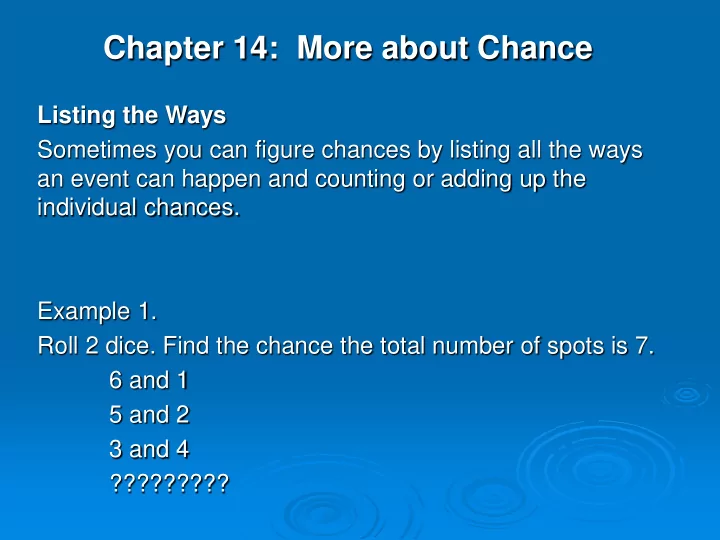

Chapter 14: More about Chance Listing the Ways Sometimes you can figure chances by listing all the ways an event can happen and counting or adding up the individual chances. Example 1. Roll 2 dice. Find the chance the total number of spots is 7. 6 and 1 5 and 2 3 and 4 ?????????
Roll 2 dice. Find the chance the total number of spots is 7. Each of the 36 possibilities has chance 1/36. The chance of rolling a “7” is 6/36 or 1/6.
Example 2. Draw 2 tickets at random with replacement from the box: 2 3 4 4 a) What is the chance that the tickets show the same number? b) What is the chance the first number is smaller than the second number? c) What is the chance that the sum of the numbers is odd?
Example 3. Draw 2 tickets at random without replacement from the box: 2 3 4 4 a) What is the chance that the tickets show the same number? b) What is the chance the first number is smaller than the second number? c) What is the chance that the sum of the numbers is odd?
Galileo (Italy, 1564 – 1642)
Gamblers in 17 th century Italy bet on the total number of spots that showed up when rolling 3 dice. They reasoned as follows: The chance of getting 9 spots is the same as the chance of getting 10 spots because the ways of getting “9” are: 1 2 6 1 3 5 1 4 4 2 3 4 2 2 5 3 3 3 the ways of getting “10” are: 1 4 5 1 3 6 2 2 6 2 3 5 2 4 4 3 3 4 BUT they knew from experience that “10” was more likely than “9” so they called in Galileo to help. Can you see their mistake?
Galileo: There is only one way to get 3 3 3: and 3 ways to get 3 3 4:
Mutually Exclusive Two things are mutually exclusive if they cannot both happen (at the same time). Examples: Toss a coin. Heads and Tails are mutually exclusive. • Toss 2 coins. Each of the following are mutually exclusive: HH, • HT, TH, TT. Roll a die. Getting a “6” and getting an odd number are mutually • exclusive. Getting a “6” and an even number are NOT mutually exclusive, because “6” is even. In a family of 4 children, getting exactly 2 boys and getting exactly • 3 boys are mutually exclusive. Toss 3 coins. Getting HHH and getting TTT are mutually • exclusive. Toss 3 coins. Getting TTT and getting at least one H are mutually • exclusive. Toss 3 coins. Getting HHH and getting at least one H are NOT • mutually exclusive.
The Addition Rule The chance that one thing OR another thing happens is the SUM of the individual chances, IF the things are mutually exclusive. Examples: • Draw a card from a pack of 52 cards: chance of ACE is 4/52 chance of QUEEN is 4/52 so the chance of ACE or QUEEN is 8/52 • Toss 3 coins: chance of TTH is 1/8 chance of THT is 1/8 chance of HTT is 1/8 so the chance of exactly 1 H is 3/8
Example 4. Toss 2 coins. Find the chance that you get at least one H. a) Find the chance that the first coin lands H or the b) second coin lands H.
Example 5. Roll 2 dice. Find the chance that you get a) Find the chance that you DON’T get b)
The Paradox of the Chevalier de Méré Game 1: Roll 4 dice. Win if at least one shows. Game 2: Roll 24 pairs of dice. Win if at least one shows.
The Chevalier de Méré (France, 1607 – 1684) decided that both games should be won with chance 2/3, but everyone knew (by experience!) that game 1 was more likely to be won than game 2. WHAT HAPPENED? The Chevalier de Méré argued: In game 1, each roll has a 1/6 chance of giving the . I want the on the 1 st , or the 2 nd , or the 3 rd , or the 4 th The chance is 1/6 + 1/6 + 1/6 + 1/6 = 4/6 = 2/3. In game 2, each pair has a 1/36 chance of giving the . I want the on the 1 st , or the 2 nd , …, or the 24 th The chance is 1/36 + 1/36 + … + 1/36 = 24/36 = 2/3.
Pascal and Fermat argued: In game 1, the chance of getting at least one is 1 – (5/6) (5/6) (5/6) (5/6) = 1 – (5/6) 4 = .518 4 terms In game 2, the chance of getting at least one is 1 – (35/36) (35/36) … (35/36) = 1 – (35/36) 24 = .491 24 terms
Pascale, France (1623 – 1662) Fermat, France (1601 – 1665)
Example 5. Roll 2 dice. Find the chance that both of the dice show a) Find the chance that neither of the dice show b) Find the chance that the dice are not both c) Find the chance that at least one of the dice shows d) Find the chance that exactly one of the dice shows e)
Example 6. Roll 3 dice. Find the chance that all of the dice show a) Find the chance that none of the dice show b) Find the chance that not all of the dice show c) Find the chance that at least one of the dice shows d) Find the chance that exactly one of the dice shows e)
Recommend
More recommend